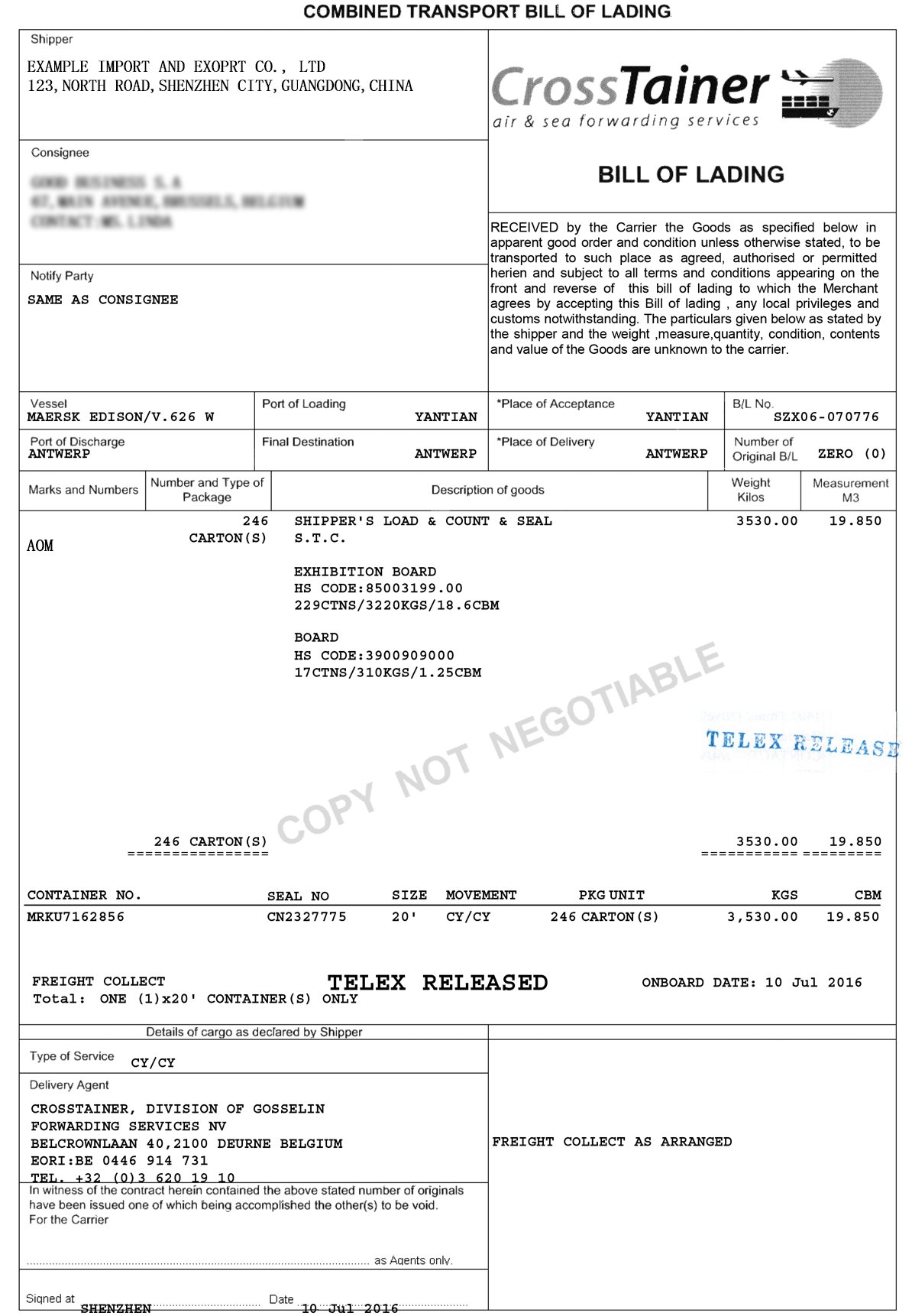Bill of Lading (B/L) Explained – A Warm, Plain-English Guide for Buyers Buying from China

Telex-released Bill of Lading (B/L Telex Release) — Yantian → Antwerp (MAERSK EDISON V.626W), 246 CTNS, 3,530 KG, 19.85 CBM.
If you import from China, you’ll meet one document again and again: the Bill of Lading. Think of it as the shipping world’s receipt + contract + key to the lock (your goods)—all in one. In this guide, I’ll keep the language simple while keeping the correct trade terms you’ll see on real paperwork.
Bill of Lading at a Glance
- A B/L is (1) proof the carrier received your cargo, (2) evidence of the carriage contract, and (3) a document of title (the “key” you use to claim the goods).
- You don’t always need paper originals. Depending on payment and risk, you might use Original B/L, Telex Release, or a Sea Waybill.
- HBL vs MBL: House B/L (by a freight forwarder) vs Master B/L (by the carrier). They work together but aren’t the same.
- Under a letter of credit (L/C), banks usually require a clean, original, negotiable B/L.
- Before cargo sails, ask for a B/L draft and check every line. Small typos cause big delays.
1) What is a Bill of Lading?
In plain language, a Bill of Lading (B/L) is:
- Receipt: proof the carrier received the goods in a stated condition and quantity.
- Evidence of contract: summary of the carriage terms between shipper and carrier.
- Title document: whoever “holds” the original, or is named correctly, can claim the cargo.
Tip: In Chinese you’ll hear “提单” (/tiːdæn/). I’ll keep English terms (with occasional Chinese in brackets) so you can match them to real documents.
2) B/L, Sea Waybill, Telex Release, or Express? (What you actually use)
| Option | What it is | How you get the goods | When to use | Notes |
|---|---|---|---|---|
| Original B/L | Paper originals (usually 3) | Present an endorsed original at destination | When payment is tied to originals; higher control | Slow if originals travel by courier; losses need replacement process |
| Telex Release | Carrier notes “original surrendered” at origin | No paper needed; released in system | After seller receives payment and surrenders originals | Fast and common; needs both parties’ agreement |
| Sea Waybill | Not a title document | Consignee proves identity to pick up | When buyer and seller trust each other (open account) | Not suitable for L/C; simple, quick release |
| Express B/L | Often used like Sea Waybill | Similar to Sea Waybill | Low-risk deals or prepaid shipments | Check carrier’s definition—terms vary by line |
Which one should you choose?
- Need tight control or L/C involved? Use Original B/L (negotiable).
- Payment done and you want speed? Telex Release.
- Regular shipments with trusted partners? Sea Waybill (fastest admin).
3) House B/L (HBL) vs Master B/L (MBL)
- MBL (Master B/L): Issued by the ocean carrier to the forwarder (or shipper). Shows the vessel, ports, and the forwarder (or shipper) as the shipper/consignee.
- HBL (House B/L): Issued by the freight forwarder to the actual shipper/consignee (you). It mirrors the MBL but lists the real trading parties.
Why it matters
- Release at destination is based on whichever B/L your delivery order depends on (ask the forwarder).
- Banking under L/C usually looks at the B/L presented to the bank (often the HBL—confirm your L/C terms).
- If you need to switch B/L (change shipper/consignee mid-route), you’re typically switching the HBL at the forwarder (with strict rules).
4) Clean vs Unclean (Foul) B/L
- Clean B/L: No remarks about damage or poor packing when the carrier received the cargo.
- Unclean/Foul B/L: Has negative remarks (e.g., “cartons wet/damaged”).
- Why you care: Under letters of credit, banks normally accept only clean B/Ls. If the B/L is foul, you may fail the L/C conditions.
5) How to Read (and fill) a B/L — Line by Line
Here’s a friendly rundown of the fields you’ll see most:
- Shipper (托运人): Usually your supplier/exporter. On an HBL, this can be the forwarder acting as shipper.
- Consignee (收货人): Who will own/pick up the goods.
- For negotiable B/Ls you may see “To Order” or “To Order of [Bank]”.
- Notify Party (通知方): Who should be informed upon arrival (could be you, your broker, or a branch).
- B/L No.: The document’s unique identifier—keep it handy.
- Place of Receipt: Where the carrier first takes custody (important for multimodal).
- Port of Loading (POL) / Port of Discharge (POD): The seaport where cargo is loaded/unloaded.
- Place of Delivery: Final handover point (can extend carrier responsibility inland—use carefully).
- Vessel / Voyage: The ship and voyage number.
- Marks & Numbers: Carton marks/carton IDs on your packages.
- Number and kind of packages: Cartons, pallets, drums, etc.
- Description of goods: Plain description (avoid sensitive claims like “food-grade” unless required).
- HS Code(s): Helps with customs classification; include if requested.
- Gross weight / Net weight / Volume (CBM): Must match booking and invoice/packing list.
- Freight terms: Freight Prepaid or Freight Collect; align with Incoterms®.
- Originals issued: Usually “3/3 originals”.
- Place and date of issue; Carrier/Agent signature.
Key tip: Always match the B/L to your commercial invoice, packing list, booking, and L/C (if have). One mismatch can hold freight at the port.
6) A simple importer timeline (from China to your door)
- Booking: You/supplier book space with a forwarder or carrier.
- B/L draft: Before sailing, you receive a draft. Check everything (names, addresses, container number, seal number, port of delivery, HS codes if shown, quantities, weights, CBM, Incoterms, freight terms).
- Sailing: Cargo loads at POL.
- Final B/L: After sailing, the carrier issues the final B/L.
- If using Originals, the shipper will get them and send to you (or to the bank).
- If using Telex Release/Sea Waybill, no physical paper.
- Payment & documents: Follow your contract or L/C.
- Arrival & release: You will received Notice of Arrival from your shipping forwarder. Your broker or you handle import customs. Present original B/L or get telex/sea waybill release.
- Delivery: Pick up from the terminal or receive last-mile delivery.
7) Pre-shipment and Pre-arrival Checklists
Before shipment
- Confirm freight terms (Prepaid/Collect).
- Agree on B/L type (Original, Telex Release, Sea Waybill).
- Share exact consignee/notify details (company name, address, contact).
- Ask for a B/L draft and cross-check with invoice/packing list.
- If under L/C, confirm the exact B/L wording the bank requires.
Before arrival
- Track ETA and destination charges.
- Prepare customs documents (invoice, packing list, B/L, permits if any).
- Plan release method (who holds originals? telex code needed?).
- Book trucking/rail onward, consider free time and demurrage.
8) Common pitfalls (and how to avoid them)
- Typos in names, addresses or phone number → Use your registered legal name and correct tax/ID where required.
- Wrong B/L type for the payment → For L/C, stick to original clean negotiable B/L unless your bank says otherwise.
- No telex approval → Confirm both origin and destination agents support telex release before you wire final payment.
- Late switch B/L request → If you need a Switch B/L, ask your forwarder early. Expect strict checks and fees.
- Freight terms confusion → “Freight Collect” isn’t always cheaper for the buyer; check local destination charges in advance.
9) FAQs
Q1: What if the original B/L is lost?
Ask the carrier about their lost B/L process. Usually it needs a letter of indemnity (and sometimes a bank guarantee). It’s slow and costly—avoid by using telex release when appropriate.
Q2: Can my freight forwarder appear as the shipper on the B/L?
Yes on HBL; that’s normal. The MBL will reflect the forwarder with the carrier. Your commercial documents still show the true exporter.
Q3: Is a Sea Waybill OK for letters of credit?
Generally no. L/Cs typically require original negotiable B/L unless the L/C explicitly allows otherwise.
Q4: How many originals do I need to surrender?
Standard is “1 of 3 original(s)”—once any one original is surrendered, the others are void. Follow the carrier’s instruction printed on the B/L.
Q5: What’s a Switch B/L and when is it used?
A Switch B/L is a replacement HBL issued (usually at an intermediate point) to change shipper/consignee details—common in trading chains. It must mirror cargo facts (no falsifying origin, weights, etc.). Expect compliance checks.
Q6: Telex Release vs Express B/L—are they the same?
Often used similarly but terminology varies by carrier. Always confirm with your forwarder/carrier how release will work at destination. In practical terms, we usually use Telex Release more often.
Key Bill of Lading Terms (Quick Glossary)
- Bill of Lading (B/L) (提单)— receipt + contract + title.
- House B/L (HBL) — issued by the forwarder to the shipper/consignee.
- Master B/L (MBL) — issued by the carrier to the forwarder/shipper.
- Telex Release — electronic notice of original surrendered; no physical paper at POD.
- Sea Waybill — non-negotiable; identity-based release.
- Clean B/L — no “damage” remarks; L/C-friendly.
- Unclean/Foul B/L — has damage remarks; risky for L/C.
- POL/POD — Port of Loading / Port of Discharge.
- Freight Prepaid/Collect — who pays ocean freight and where.
- Incoterms — trade terms that split cost/risk between seller and buyer.
If any assistant need when buying from China, you are welcome to contact with us anytime.
Our Contact Information as below:
Email:kevin@china-buying-support.com
Phone | WhatsApp:+86 1860 5899 103
Thank you.
Joining Us With 1,200+ Happy Clients Enjoying Buying From China now!
Becoming One of China-Buying-Support family to Get a Easier and Trouble-Free Sourcing and Shipping Service.


